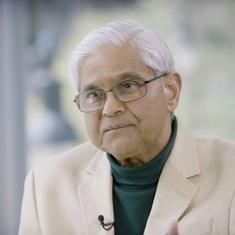Amid all the cultural and legislative wars that the Bharatiya Janata Party under Narendra Modi has been willing to spark, its effort on the Goods and Services Tax stands apart. The GST is an attempt to turn India into a common market with regard to indirect taxes, and it came closer to being a reality after the passage of crucial legislation in the Lok Sabha on Wednesday. But unlike beef bans or demonetisation, GST is the Modi government’s first momentous legislative achievement, one that is the result of persuasion and collaboration, not just reliance on the brute Lok Sabha majority.
The Lok Sabha passed four bills related to GST on Wednesday, which together cover the way the new tax will actually be applied across the country and what that will entail for the fiscal relationship between the Centre and the states. The GST subsumes all indirect taxes, from service tax to the octroi collected on roadsides, with the aim of having one common tax applicable to goods and services across India. The aim: A common market with less red tape, which the government hopes will encourage business and raise India’s Gross Domestic Product by several percentage points.
If the celebration of GST’s passage through Parliament seems like deja vu, it is because the more significant legislative portion – an amendment to the Constitution that rejigs the way the Indian Union works – was already passed by Parliament in August 2016.
Legislative effort
But that does not make the introduction and passage of the four bills in the Lok Sabha any less impressive. The Constitutional Amendment only reaffirmed a commitment to the concept of the GST, which ended up having widespread support. Following that, Finance Minister Arun Jaitley had to coordinate dozens of meetings of the GST Council, a statutory panel that features representatives from all the states and requires a three-fourths majority for any measure to be passed.
Jaitley had originally hoped that the Council would hash out the various contentious portions of the GST bills by the Winter Session of Parliament in December 2016, so that the Centre could roll out the new tax by April 1, the start of the financial year. But a number of issues, from the compensation that the Centre will give to states to the division of taxation powers, took longer to be ironed out.
It now seems likely that the GST will be in place by July 1. How smooth this process will be depends on how much clarity the government will offer on the specifics, once the Bills – which still have to go to the Rajya Sabha and then get presidential assent – have been notified. The roll-out will no doubt feature some confusion and could lead to price rise as businesses move over to the new system and tax rate.
Taxing times
Unlike demonetisation, which forced serious hardship in return for nebulous gains, the GST is designed to improve lives after the initial pains of adoption. It is hard to estimate just how positive the new tax will be for the economy, since it is after all a fundamental change in the way India works. But the removal of red tape, a taxation system that is more transparent and a pan-Indian tax rate should act as a boost to the economy.
Not all of it may be positive. The GST Council might be the most federal body India has ever created, but it still requires consensus, making it harder for individual states to innovate in their own taxation efforts. In effect, GST takes a union that is heavily centralised and concentrates that power even further.
There are also questions on many provisions within the introduced bill, such as an anti-profiteering clause that could lead to inspector raj. And there is a lack of clarity on the network being set up to administer the tax reform, where the government only holds 49% ownership.
Big bang reform
But, two years after the chief economic adviser to the prime minister argued for incrementalism over big bang reforms, Modi and Jaitley have managed to deliver on an effort that has been more than a decade in the making. GST’s roots lie in the Value Added Tax proposals that began under former Prime Minister Atal Bihari Vajpayee, which continued to build under the United Progressive alliance.
It was initially one of two big pieces of legislation that Modi hoped to pass, the other being an altered Land Acquisition Act which was eventually junked after much opposition from the public. Because GST needed to first be a constitutional amendment, requiring approval from two-thirds of Parliament and half of all state assemblies, the government couldn’t rely on its brute majority in the Lok Sabha to pass the bill.
Instead, it had to cajole, persuade and threaten various states to come on board, building consensus through the GST Council. Ultimately, the BJP-run government successfully designed a taxation and federal structure that could end up being the most lasting achievement of Modi’s tenure that has nothing to do with Ram.










